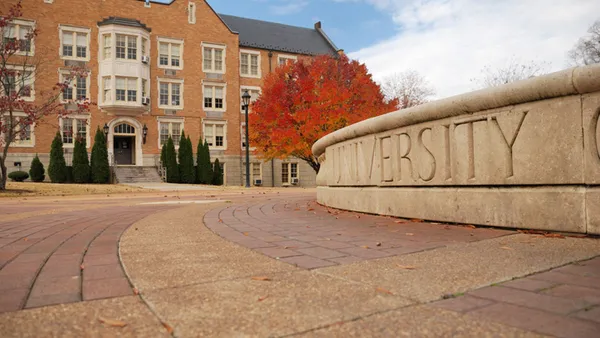Dive Brief:
- Charitable giving to U.S. colleges increased 5.1% in fiscal year 2021 when accounting for inflation. A strong stock market, alumni giving and donor-advised funds drove the increase, according to an annual survey from the Council for Advancement and Support of Education.
- Capital-purpose giving rose 6.6% when adjusted for inflation and largely came in the form of endowment gifts, instead of tangible property like buildings.
- Based on the first half of the 2022 fiscal year, the survey predicts higher ed charitable giving will continue to rise, but at a slower rate than in the previous year.
Dive Insight:
The uptick in donations for the year ending June 30, 2021, followed a year with almost no change to higher education charitable giving.
"That's a fairly strong rate of growth, even in less-volatile social conditions," said Ann Kaplan, senior director of the Voluntary Support of Education Survey, or VSE, at CASE. "One of the things that really drives the level of giving, in any particular year, is the stock market."
During fiscal year 2021, which ended June 30, the stock market saw record highs, with the country experiencing a modest level of inflation. Donors had more assets to disperse than the year before, when the U.S. first began feeling the effects of the COVID-19 pandemic.
"People didn't know what to do with all this unexpected wealth, because no one expected the stock market's performance," said Kaplan. One popular option was donor-advised funds, which allow people to donate assets like stocks and receive an immediate tax deduction, while still deciding later how the donation will be used.
CASE's annual VSE survey analyzed data from 864 higher education institutions, with just under half of participants reporting on donor-advised funds. At those colleges, giving to donor-advised funds increased by 26.5% in 2021.
Donor-advised funds are considered among the fastest-growing charitable giving vehicles.
Alumni giving to capital purposes and current operations rose by 23.4% and 6.3% respectively, among the colleges that gave details about alumni giving.
"The driver of almost all of this philanthropy is individuals," said Kaplan.
Across all donation sources, unrestricted contributions increased by an unprecedented 30.2%. Unrestricted gifts can be among the most valuable to colleges because they are not earmarked for specific purposes, but they make up only 7.4% of contributions to survey respondents.
Much of this growth came from large contributions made by author and major Amazon shareholder MacKenzie Scott, according to the survey. Scott donated over $800 million to colleges in 2020 before announcing even more higher ed giving in June 2021, with a focus on historically Black colleges and universities. Many of the donations were made without restriction to institutions that normally receive smaller dollar amounts.
The survey also listed contributions from businessman Michael Bloomberg and the Lilly Endowment as reasons for a bump in giving to private specialized institutions.














